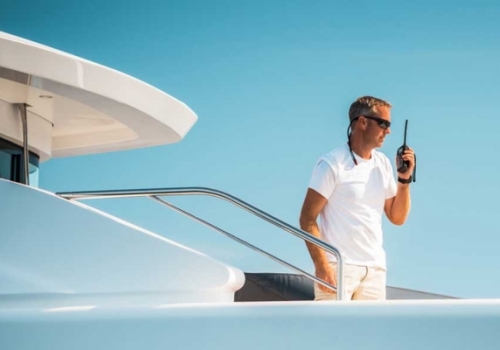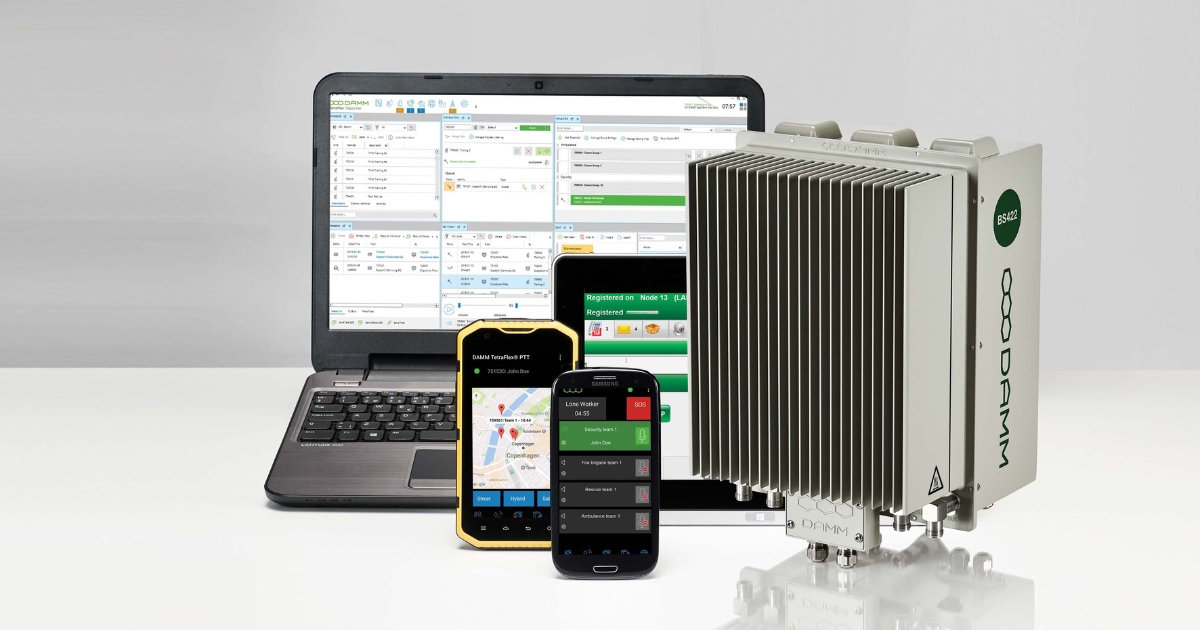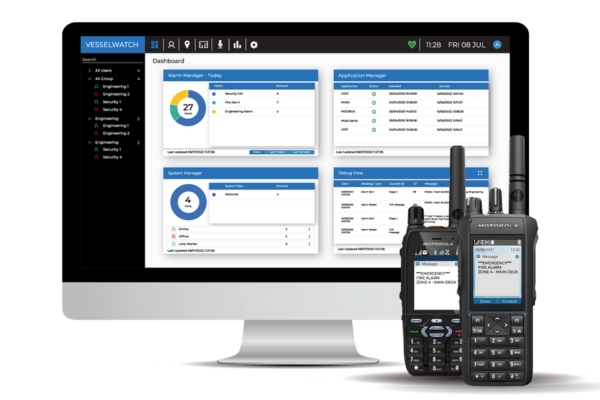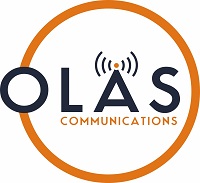What is the Future of Crew Radio Communications?

While we have seen some impressive advances in satellite and cellular communications over recent years, crew UHF radio communications have not enjoyed the same leaps forward. On board a superyacht you will find some of the most advanced technology available in the world, which can aid in reducing isolation by allowing international phone calls or streaming TV shows at your fingertips. So why do so many vessels have issues talking between the bridge and ECR or crew ashore?
Why do we need radios?
The primary regulation involving crew communications can be found in the SOLAS Chapter II-2, Regulation 10.10.4. This lays out the minimum safety standards for the fire team and states: “For ships constructed on or after 1 July 2014, a minimum of two two-way portable radiotelephone apparatus for each fire party for fire-fighters' communication shall be carried on board. Those two two-way radiotelephone apparatuses shall be of an explosion-proof type or intrinsically safe. Ships constructed before 1 July 2014 shall comply with the requirements of this paragraph not later than the first survey after 1 July 2018.”
The need to have an explosion-proof (ATEX) or intrinsically safe radio is a must. The decision on whether the fire team radios need to be ATEX or intrinsically safe is dictated by the vessel's flag state. It would make logical sense that the fire team radios also need to communicate with other crew or areas i.e. the incident commander, bridge, or engine room for coordination purposes. As a fire can occur in any area on board including confined spaces, the fire team must be able to operate with unimpeded communications.
How has radio evolved?
Radios on board previously used analogue technology which allowed communications to be heard by others not on board. Another common issue was the limited eight available frequencies as defined by the ITU for UHF onboard communications. This often caused interference in busy marinas. For larger vessels, repeaters or “boosters” are connected to an onboard antenna system providing vessel-wide communications. Each repeater would provide one single channel that could be used with the antenna system. To allow for multiple channels multiple repeaters had to be installed which required a lot of space within the AVIT racks.
As technology has advanced, digital mobile radio (DMR) and Terrestrial Trunked Radio (TETRA) became commonplace on board. The advantages of these systems meant a reduction in rack equipment and an increase in features.

What are the key features of these systems?
DMR
-
Double the voice channels per repeater vs. analogue repeaters.
-
Increased features such as text messages or private calling between radios.
-
Upgraded security to stop unwanted listeners.
-
Over-the-air programming is possible via RF and Wi-Fi.
-
DMR is a cost effective solution.
TETRA
-
TETRA has superb audio quality, making it a great choice for safety onboard.
-
Full-duplex calls are possible between radios and via a PABX, which means that you don't need to carry mobile phones or DECT phones.
-
1 TETRA carrier provides 3 voice channels reducing rack space.
-
TETRA has data integration and location tracking, which can be integrated with peripheral equipment via data terminals.
-
Over-the-air programming is possible via RF and Wi-Fi.
What is the future of crew radio communications?
As the demand for data heavy features increases, crew communications systems will utilise the advancements seen in cellular and satellite communications. Hybrid TETRA (Terrestrial Trunked Radio) and cellular devices represent the future of communication solutions in various industries, including maritime settings. These hybrid devices combine the strengths of both TETRA and cellular technologies to create a versatile and resilient communication system that addresses the specific needs and challenges of modern communication requirements. Some benefits include:
-
Enhanced Coverage and Connectivity: One of the main advantages of hybrid TETRA and cellular/IP devices is their ability to switch between TETRA and data networks based on signal strength and availability. This ensures that users have seamless connectivity even in areas with weak or fluctuating signals. While TETRA networks offer robust coverage in remote or challenging environments, cellular networks provide broader coverage closer to land. Hybrid devices allow for communication beyond the line of sight without an increase in infrastructure this is ideal for tender operations or a run ashore.
-
Redundancy and Reliability: The hybrid approach enhances redundancy in communication. If one network experiences downtime or disruption, the device can automatically switch to the alternate network, minimising communication gaps. Why not create your own network with a Wi-Fi access point connected to a Starlink terminal on a tender to create a beyond-line-of-sight network?
-
Integration with Data Services: Hybrid devices can also incorporate data services, allowing users to access information beyond voice communication. This is especially valuable for maritime operations that require real-time access to data, weather updates, navigational information, and more. Integrating data services with hybrid devices enhances operational efficiency and situational awareness.
 What are data services?
What are data services?
Data services have transformed radios into more than just tools for voice conversations. Through the integration of powerful software applications such as VesselWatch, a seamless interconnection of all onboard systems has become a reality. Consequently, crew members can now receive the right alarms instantaneously, eliminating the need to navigate the vessel to access a control panel. This system not only enhances the guest experience by directly integrating with AV systems such as Crestron or WiFi buttons but also enhances onboard safety by enabling AMCS, fire, or navigation alarms to be relayed directly to key personnel.
The inclusion of hybrid devices expands the utility of data beyond onboard systems. Utilising GPS tracking, these devices offer the capability of providing early warnings for guest returns or facilitating Tender or toy tracking. Moreover, the convenience of carrying a single device provides access to vital information such as system schematics, emails, or remote support from suppliers to troubleshoot onboard equipment.
An example would be if a tender has a fault, this can relay the information directly to the engineering team to allow a quick first line fix. In addition, hybrid devices grant designated individuals ashore (DPA) access to verify safety drills being conducted from any location worldwide. Hybrid devices can also allow vessels operating as a fleet, to communicate between the motherships and support vessels without a UHF line of sight.
Envisioning the future of crew radio communications, a transformative evolution is underway. The maritime industry, bound by regulations and the imperative of reliable communication, is experiencing a gradual shift towards innovative solutions that embrace both tradition and technology. The journey from analogue to digital technologies, as witnessed with the advent of DMR and TETRA systems, has already paved the way for enhanced features, improved security, and streamlined operations.
As we gaze ahead, the path leads to the convergence of cutting-edge cellular and satellite communications with established radio technologies. The emergence of hybrid TETRA and cellular devices offers a glimpse into the promising landscape of crew communication systems. This hybrid approach harnesses the strengths of both worlds, ensuring seamless connectivity even in challenging environments, and safeguarding against disruptions through automatic network switching. Beyond voice communication, the integration of data services elevates radios to multifunctional tools, enhancing situational awareness, operational efficiency, and onboard safety.
The marriage of data services and hybrid devices transcends the confines of the vessel, enabling real-time access to vital information and fostering collaboration among fleet operations. GPS tracking empowers early warnings and seamless coordination, while shoreside personnel can remotely support and verify safety procedures. The expanding horizons of communication echo a future where crew members are not only connected across the ship but also with a global network of support and resources.
In this dynamic landscape, where tradition and innovation intersect, the evolution of crew radio communications is an ongoing saga of adaptability and progress. As maritime technology continues to chart new courses, the voice of the crew, once confined to UHF frequencies, resonates far beyond, shaping the maritime industry's communication destiny.


Post your comment
You cannot post comments until you have logged in.
Login to post a commentComments
No one has commented on this page yet.
RSS feed for comments on this page | RSS feed for all comments